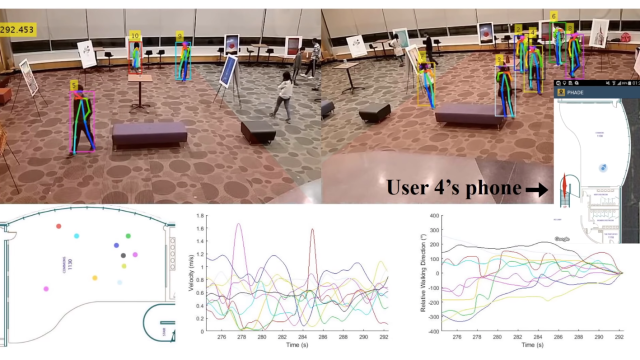Researchers at Purdue University have found a new way to get surveillance cameras to “talk” to the people they see. The system is called PHADE, which stands for “private human addressing”, and it enables cameras to send messages to people’s devices when they have entered a specific area without collecting their personal data.
Screenshot: Purdue
Instead of using an IP or MAC address, cameras equipped with PHADE create an “address code” based on a person’s motion patterns when they have entered their field of view. PHADE builds a packet with a customised message linked to that address code, and then broadcasts it out.
If a target’s smartphone has the other end of PHADE’s tech, it builds a second address based on a user’s movement, comparing it to those attached to any packets it receives. If the two address codes match, the message is delivered.
The researchers claim PHADE protects privacy by “blurring” distinguishing data linked to the address codes and never extracting any data from the phone itself. The researchers posted a video summarising their findings, testing out the PHADE system by sending messages to different individuals based on where they were standing in a mock museum. They claim a 90 per cent correct matching rate.
The researchers sent visitors information based on what artwork they were looking at, but another, more plausible application is in supermarkets. Imagine browsing through the aisles of a store and receiving updates on products as you browse. PHADE is still in research stages, but retailers are already exploring tracking shoppers as they move in the stores.
Like many aspects of retail surveillance, police departments would undoubtedly be interested in the technology as well.
“PHADE may also be used by government agencies to enhance public safety,” Siyuan Cao, co-author and PhD student, said in a press release. “For example, the government can deploy cameras in high-crime or high-accident areas and warn specific users about potential threats, such as suspicious followers.”
PHADE could be used to warn people of potential threats, say, following a terror attack, or to send the details of a missing child in the shopping centre where they were last seen.
But once installed on users’ phones, how would this same technology be applied in the public or private realms beyond museums or supermarkets? Could factory workers receive penalising text messages if they enter a break area? Could protesters in an off-limits area be spammed with messages to prevent them from communicating with each other?
The technology is still nascent, but if the researchers are already eyeing government or public safety applications, it’s important to ask.
